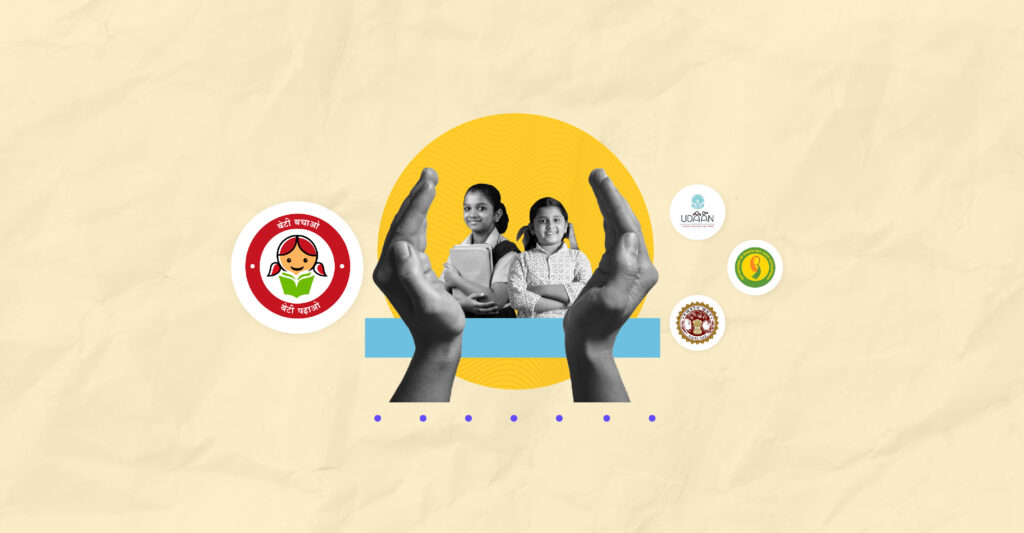Last Updated on Jun 22, 2022 by Aradhana Gotur
Over time, the government has taken several measures to uplift girl children and the societal attitude toward them. Various welfare schemes and financial aid programs have been launched for their welfare, health, and education. All of these aim to facilitate an equal opportunity for girls and boys in society. In this article, we discuss the top 10 government schemes for a girl child in India.
Table of Contents
Benefits of government schemes for a girl child in India
- The government schemes for a girl child in India mainly focus on their welfare.
- While some schemes aim to increase their sex ratio, others offer financial aid for their education and wedding expenses.
- Some of these schemes for a girl child in India offer tax benefits.
10 government schemes for a girl child in India
Following are some schemes for girls in India along with their benefits, features, eligibility, and application process.
1. Balika Samridhi Yojana
Launched on 2 October 1991, the Balika Samriddhi Yojana is one of the central government schemes for a girl child that caters to families Below Poverty Line (BPL) in rural and urban areas. It covers up to two girl children born on or after 15 August 1997. Currently, eligible girl children under the scheme are given Rs 500 as a post-birth grant and annual scholarships as follows:
| Class | Annual scholarship |
| I to III | Rs 300 for each class |
| IV | Rs 500 |
| V | Rs 600 |
| VI to VII | Rs 700 for each class |
| VIII | Rs 800 |
| IX to X | Rs 1,000 |
Eligibility criteria of Balika Samridhi Yojana
- This scheme is only available for girl children born to families under the Below Poverty Line category on or after 15 August 1997.
- Rural families claiming the scheme should belong to the BPL category per the criteria set under Swarnajayanti Gram Swarozgar Yojana.
- In urban areas, families living in slums, regardless of their recognition, those working as rag-pickers, vegetables and fruit sellers, payment vendors and so on are covered.
- The scheme applies to only two girl children from every family.
How to apply for Balika Samridhi Yojana?
The scheme is implemented through the Integrated Child Development Services (ICDS) in rural areas and the Health Department in urban areas. Eligible families must follow the below steps to apply:
- Obtain the application form online from the Women and Child Development website. Alternatively, the form is also available offline with Anganwadi Workers and the Health Functionaries in rural areas.
- Duly fill out the form with all the details.
- Submit the form where you obtained it from.
Withdrawal of funds and other guidelines
- The grant mentioned above is deposited in an interest-bearing account opened in the name of the girl child and an officer allotted by the State Government/Union Territory. The account is opened in the nearest post office or bank.
- The account will mature when the girl child attains the age of 18 yrs.
- No premature withdrawal from the account is allowed.
- On attaining 18 yrs of age, the girl child can withdraw the funds by producing a certificate stating that she is unmarried. She can obtain this from the Gram Panchayat/Municipality.
- If the girl child is married before the age of 18, she will have to forgo the annual scholarships and the interest accrued thereon. She will only be entitled to receive the post-birth grant of Rs 500 and interest accrued on it.
2. Beti Bachao Beti Padhao
This is also one of the central government schemes for a girl child introduced to focus on wellbeing. Initially, this central government scheme was targeted at districts with low sex ratios, that is, fewer female children compared to their counterparts. Now, the Beti Bachao Beti Padhao campaign applies to other parts of the country. The scheme does not entail direct cash transfer but aims to:
- Improve the child sex ratio.
- Prevent gender-biased and sex-selective elimination.
- Ensure the survival of the girl child and her protection.
- Encourage the education and participation of the girl child.
- Achieve gender equality and women empowerment.
The scheme has three components:
- Advocacy and media campaigns: National awareness campaigns involving a media approach are launched to educate parents. These campaigns also focused on destigmatising the birth of girl children, ensuring their birth, growth, and education are without discrimination.
- Interventions in gender-critical districts: Incentives designed to improve the Child Sex Ratio (CSR) and sex ratio at birth in 640 identified gender-critical districts.
- A financial incentive-linked scheme: Sukanya Samriddhi Yojana (SSY), a small deposit-saving scheme, was launched to facilitate parents to save for their girl children. The scheme offers income tax benefits and an attractive interest rate of 7.6% on the deposit.
3. CBSE Udaan Scheme
Administered by the Central Board of Secondary Education (CBSE) through the Ministry of Human Resource Development, CBSE Udaan is one of the government schemes for girl child education. It focuses on increasing their enrollment in prestigious technical and engineering colleges across India. The following are the features of the scheme:
- Free course material and online resources are offered for girl students in 11th and 12th standards.
- Peer learning and mentoring opportunities are offered to meritorious girl students.
- Virtual contact classes in 11th and 12th classes are held on weekends.
- Constant monitoring and tracking of students’ progress.
- Study helpline services to clarify the doubts of girl students.
Eligibility criteria for CBSE Udaan Scheme
- Girls should have Indian citizenship and reside in India
- The girl student should be enrolled in Physics, Chemistry or Mathematics stream in the 11th and 12th classes of CBSE-affiliated schools
- The annual family income of the student should be less than Rs 6 lakh
- Selection of girl students is made based on merit
4. Mazi Kanya Bhagyashree Scheme
Launched by the Maharashtra Government, the Mazi Kanya Bhagyashree scheme provides monetary benefits to the mother of a girl child as follows:
- Rs 5,000 for the first 5 yrs after the birth of the daughter
- Rs 2,500 per year until she reaches Grade V
- Rs 3,000 per year until she reaches Grade XII
- After completing 18 yrs, she will be paid Rs 1 lakh per year for her further education
Eligibility criteria of the Mazi Kanya Bhagyashree Scheme
- The scheme applies to all permanent residents of Maharashtra
- The scheme only applies to a family belonging to the Below Poverty Line category
Documents required to apply for Mazi Kanya Bhagyashree Scheme
- Domicile certificate of the State of Maharashtra
- Girl child’s birth certificate
- The parents’ income certificate
- Ration card or BPL card
- Bank passbook of the girl child with IFSC code
How to apply for the Mazi Kanya Bhagyashree Scheme?
- Obtain the application form from the local Anganwadi or download it from the Maharashtra Government’s official website
- Submitted the duly filled form along with all the applicable documents to the Anganwadi
5. Mukhyamantri Kanya Suraksha Yojana
This scheme for a girl child is a reward programme introduced by the Bihar Government. The Mukhyamantri Kanya Suraksha Yojana releases Rs 2,000 to the parents after the birth of a girl child. They can avail this on producing her birth certificate.
Eligibility criteria of Mukhyamantri Kanya Suraksha Yojana
- Applies to the permanent residents of Bihar only.
- The applicant should be from a Below Poverty Line family.
How to apply for Mukhyamantri Kanya Suraksha Yojana?
The applicant can reach out to the Collector’s office, Gram Panchayat or Zilla Parishad to apply for the scheme. Alternatively, they can also submit a duly filled application form at their nearest Anganwadi centre.
6. Laadli Yojana of Jharkhand
This savings scheme makes an initial deposit of Rs 6,000 into the girl’s post office savings account for a fixed tenure of 5 yrs. The girl child then receives the monetary benefits in regular intervals as follows:
- Rs 2,000 on starting Grade VI
- Rs 4,000 on starting Grade IX
- Rs 7,500 on starting Grade XI
- A monthly stipend of Rs 200
The deposited amount will mature when the girl attains 21 yrs of age. This can then be used to meet her marriage expenses.
Eligibility criteria for Laadli Yojana of Jharkhand
- The applicant must be a permanent resident of Jharkhand
- The applicant should be from a ‘Below Poverty Line’ family
7. Ladli Scheme of Haryana
This scheme can only be availed if one of the girl child’s parents is from Haryana. The applicant should be able to prove this by producing the domicile certificate. The scheme pays a sum of Rs 5,000 per year for 5 yrs, which gets accumulated in the Kisan Vikas Patra opened in the mother’s name. After the girl turns 18, she can withdraw the money. The money is immediately released to the parents in two instalments if a second child is born.
How to apply for the Ladli Scheme of Haryana?
The mother and the child should be registered at the nearest Aganwadi centre to receive the benefits of the scheme.
8. Mukhyamantri Rajshri Yojana
Launched by the Rajasthan Government, the Mukhyamantri Rajshri Yojana offers monetary benefits to the parents of a girl child at various stages:
- Rs 2,500 is paid to the mother on the birth of a girl child
- Rs 2,500 is given via a cheque once the girl child completes a year
- Rs 4,000 is paid on the girl child’s admission to any public school into Grade I
- Rs 5,000 is paid when the child starts Grade VI
- Rs 11,000 is paid when the girl starts Grade XI
Who is eligible for the scheme?
- Applicant should be a permanent resident of Rajasthan.
- Applicable to a girl child born after 1 June 2016.
How to apply for the scheme?
You can apply for the scheme by registering at the nearest designated bank, Collector’s Office, Gram Panchayat or Zilla Parishad.
9. Nanda Devi Kanya Yojana
Specific to Uttarakhand, this scheme contributes a fixed deposit of Rs 1,500 in the name of a newborn girl child. This, along with the accrued interest, is given to the girl child on attaining the age of 18 yrs and completing her higher education.
Eligibility criteria for the scheme
- Applicable to permanent residents of Uttarakhand
- The applicant should be from a ‘Below Poverty Line’ family
- Only two girls from a household are eligible
10. Sukanya Samriddhi Yojana
Sukanya Samriddhi Yojana (SSY) is a government-backed savings scheme which encourages parents to systematically save for their girl child’s higher education and wedding.
Eligibility criteria and guidelines of SSY
- Parents and guardians of a girl child aged below 10 yrs can open this account
- One girl child can have only one SSY account
- Parents are allowed to open up to two accounts for two girl children. Twins and triplets are exceptions
- The account can be transferred anywhere in the country on submitting address proof
- The parents can access this account at any post office or bank branch
- Annually, a minimum deposit of Rs 250 and a maximum of Rs 1.5 lakh has to be made to the account
- SSY enjoy EEE tax status, which means parents can claim tax benefits on deposit, interest accrued, and the maturity proceeds
- The maximum tenure of the account is 21 yrs from the date of opening of the account or the date on which the girl gets married, whichever is earlier
- Deposits are allowed for a maximum of 15 yrs from the account opening date
- A partial withdrawal of 50% can be made once the girl attains 18 yrs of age
- An account can be pre-closed to meet the wedding expenses of the girl child, provided she is 18 and can furnish relevant proofs
- The account earns a fixed interest rate of 7.6% as of Q1 FY 2022-23
FAQs regarding schemes for a girl child in India
Where should you register for government schemes for girls in India?
You can register for the above-discussed government schemes for girls on the designated platform: government banks, authorised private banks, post offices, Anganwadi centres, Health Departments, Women and Child Development, and so on. Alternatively, you can also register online by submitting a duly filled form.
Can you avail a loan against the Sukanya Samriddhi Yojana Account?
No, you cannot avail a loan against an SSY account. However, you can make a partial withdrawal of 50% once the girl attains 18 yrs of age.
Which government schemes for girls are best?
All of the above schemes are specially designed to benefit girl children. You can choose the one that works for you the best. If you wish to accumulate a trust fund for your daughter, you can go for SSY. Alternatively, if you are a resident of Maharashtra and want to fund your daughter’s education, you can go for Mazi Kanya Bhagyashree Scheme and so on.
- Best Performing Index Funds in India (2025) - Jun 5, 2025
- Issue of Shares – Meaning, Types, Examples and Steps - Jun 4, 2025
- Banking Mergers in India – List of Merged PSU Banks, Advantages, and Challenges - Jun 3, 2025





